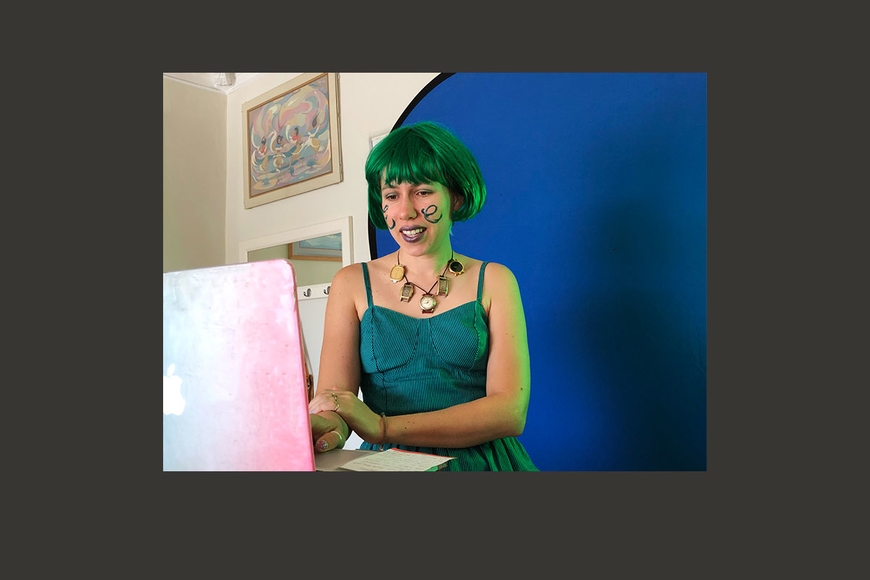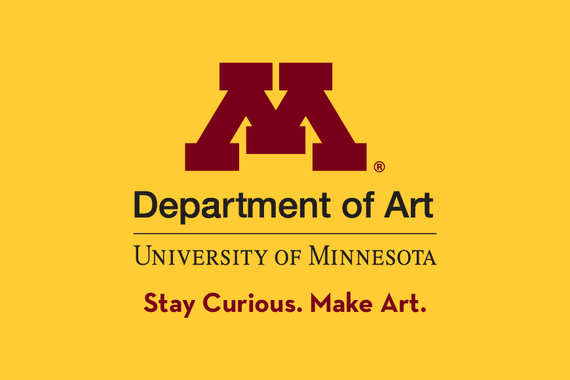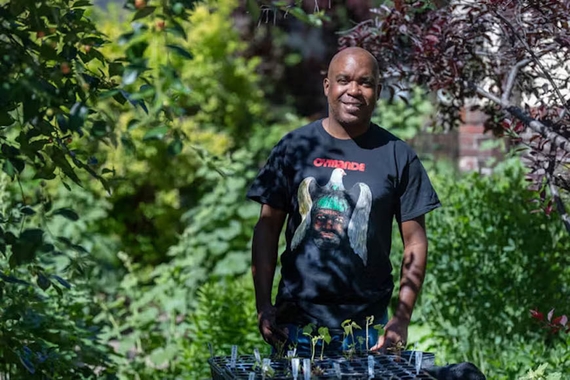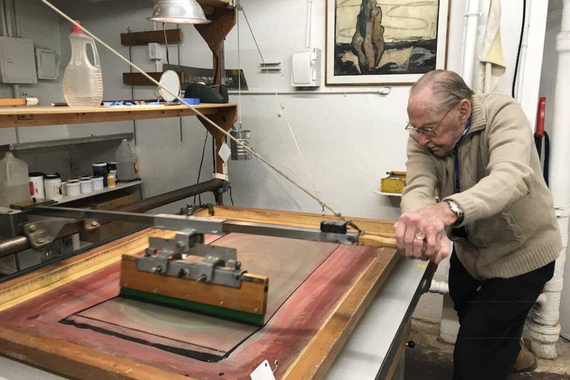Interdisciplinary: Relating to More Than One
"I found strength working in the intersections of collaborative performance, video technology, the environment, and social justice, which are all still core to my work today."
A performance artist from warmer climates, Reb L. Limerick braved the cold weather to become the first MFA graduate of the Department's Interdisciplinary Art and Social Practice area in 2018. Now a working artist and educator, Reb is back in California, teaching and blending sound, sight, tech, and ecology. We grabbed a few moments with Reb to learn more about her artistic path, teaching high schoolers, and navigating performance art in a pandemic.
Q: How did you know you would become / or decide “I’m an artist?”
A: Art has always been a huge part of my life. At the age of 4, I began acting, singing, and dancing in community theatre. At home, my mom was a great inspiration and supportive force, as she was an arts educator for 37 years. Where I grew-up in Florida, there was a public arts magnet middle school that was competitive. My strategy was to audition for a theatre placement with a film/video "back-up" audition. That's when I created my first experimental video, my audition piece was titled "Construction, Destruction." I filmed out the window of a moving car with a poetic voiceover and began to understand video as art and storytelling. Well they must’ve been taken with my environmentalist video poem, because I was accepted to study communication arts. Following that I went to AW Dreyfoos Jr. School for the Arts in West Palm Beach, Florida for Musical Theatre, and continued to build my performance and video skills.
What I am drawn to in performance and video arts is that they are more collaborative, rather than individual. As a child and teenager, I considered myself a performer, it wasn't until college that I thought of myself as an artist.
Q: What brought you to the UMN?
A: When it was time to pursue an undergraduate program, I landed at University of California - San Diego, in the Visual Arts (media) program with a film/video sub-major, poetry minor. I sought to integrate my interests and college gave me the confidence to say "I'm a performance artist” and "video artist," not just a performer or person who makes videos. I constantly wanted to do all things--perform, direct, be behind the camera, write, and sing. My mentors stressed that I needed to "pick something and go in-depth," but I continually resisted choosing a singular discipline.
After college, I moved to LA and felt overwhelmed, I was impatient to find "my people," and realized I was lacking the skills of how to be a professional artist. I didn't have the structure I was used to and struggled a bit. An MFA program would provide me the framework I needed, so I began to look for programs that were interdisciplinary--where I'd be able to find like minded collaborators and make a body of work that would allow me to achieve the success I sought. My approach was a targeted keyword Google search on terms such as "experimental media," and researching favorite artists and where they went to school. That's when I learned that Maria Bamford, one of my favorite comedic performers, completed her undergrad at the U, which then brought me to the U of MN website.
My mom and I took a roadtrip to Minneapolis to tour and learn more about what was then the Experiential Media Arts MFA. It was a particularly cold November! But, I walked around and looked across a bridge that spans the Mississippi, my fingers were freezing, yet the body of water was compelling. Being underdressed for the weather I bought a pair of Carhartt overalls from a secondhand store in Dinkytown and wore those the whole weekend. During my tour, I met Diane Willow, Jan Estep, and Chris Baeumler. While Chris was meeting with me, she noticed my Carhartts and joked, "you're already dressed and ready to come here!" Coming to the U; all the signs were pointing to "yes."
Q. How did your time as an MFA student impact your creative approach? Or - is there a takeaway from the program that is still with you as an artist today?
A: The most impactful force was the Mississippi River, the proximity was powerful. I'd always lived near oceans, so this body of water was important for my sense of well-being. However, it became even more vital for me as an artist. Diane brought Pauline Oliveros of the Deep Listening Institute to our Improvising Ecosystems ensemble; this launched a huge shift for me from singing to listening in a much more thoughtful and deliberate way. Diane Willow, Chris Baeumler, my cohort, and other loved ones helped me center my work in our human connection to earth. I found strength working in the intersections of collaborative performance, video technology, the environment, and social justice, which are all still core to my work today. The U of MN is also where I created my personas: Reb L. Yell: your personal cheerleader, Silver Baby: a child of our digital age, and Ecca Echo: the ecosexual pop star. These characters are still “regulars” in my life as an artist.
Q: What inspired you to become an arts educator?
A: A combination of things. I'd spent so much time as a student, then a teacher's assistant, (TA), I felt it made sense to try it from another angle. As a TA in Christina Schmid's lecture classes of 80 students, I bore witness to the magnetism of a dynamic lecturer actively engaging students to participate at an impressive scale. I was also a TA for the Grand Challenges: Making Sense of Climate Change course, which was a brand new class and I was able to help shape it and form a sense of agency around my own teaching methods within project-based learning. Then, because I was the first MFA student to graduate in the Interdisciplinary Art and Social Practice area, I had a really amazing opportunity to interact with faculty regularly to help shape this new area. These conversations gave me an eye into what it would be like to work as faculty in an institution of learning. As I learned to navigate the institution, I wanted to make positive systemic changes, which led me to my leadership role as Grad Rep and eventually to my current role as Coordinator of Diversity, Equity, and Inclusion at Harvard-Westlake Upper School. It was the culmination of all of these things that gave me confidence in what I could do in a school; helped me understand my strengths as a classroom catalyst and changemaker. Importantly, I realized that teaching fulfilled me.
Q: You're teaching grades 10-12; what are you learning?
A: I just really give my all to whatever I do. My predecessor was at Harvard-Westlake School for 31+ years, so I've inherited her amazing legacy. When I became part of the Visual Arts Faculty and stepped into the Westflix Student Film Festival Co-Director position in 2019, I saw a vision that I too, could be here for 30 years.
Each day, I'm learning along with my students. I have amazing agency and responsibility in designing my own curriculum. Consistently, I do a deep dive into a new subject or genre to be able to teach them and to spark questions. With my seniors in Video Art 3, we are delving into creating short films informed by surveillance and observation, asking questions such as: What deserves a deeper look? How am I shaped by how I am seen? What am I seeing now? These are all students born after September 11, 2001. In their lifetimes, there have been constant cameras on us, and we have become collectively equipped with camera phones. We are investigating the power to observe and share images that cause global uprisings. But also the quieter observations in our own neighborhoods; I always show students Kevin Obsatz's Tree Work film.
I also co-direct the HWGo! Storytelling Adventures Program. Last November, we designed a field trip opportunity for students to engage with multiple sites of water ecologies in Southern California in order to create experimental documentaries. Unfortunately the LA River is the longest concrete canal in the world, and the Salton Sea is a polluted disaster, but how were past decisions made about these previously lush bodies of water that have led us to where we are now? It's a passion of mine to be able to teach them the intersection of ecology, society, and the artistry of observation.
Q: What do you hope students come away with from your classes? Have you seen “aha moments”?
A: A local interdisciplinary vocalist named Odeya Nini brings together the way sound feels in your body and the shape of sound in the air, which inspires me. I brought Odeya to our school community as a visiting artist; the students met with Odeya under a bridge down by the LA River to experiment with sonic vibrations. Students really went for it, playfully experimenting with one another; in this workshop they sang and explored their own capacities for sound-making. It was a novel situation that allowed them to overcome the fear of not being cool, move through their fears to perform in public space or in front of the camera. I strive to create a safe or brave space where students feel comfortable to try something new, bring that sense of confidence into their art as well as their life. Be bold. An environment for artistic risks, taking those and celebrating them. Rather than an "aha moment," it's more like a slow build over the school-year.
Q: How is the pandemic impacting your work? If so, what's your pivot?
A: Because I primarily identify as a performance artist, not having a live audience and that audience interaction/participation is a bit of a bummer. While I've done a handful of virtual performances, the Ecca Echo character does work well in a Zoom cabaret context, I still really miss having the energy of a live audience in person. One recent piece that felt more satisfying than trying to replicate one of my typical performances, was called "Power PowerPoint." This performative digital presentation utilized wordplay and found imagery to draw connections between power dynamics in our world, such as a single unit of power, a watt, and LA's Watts Neighborhood uprisings. I've also been working on new Ecca Echo songs with my collaborator, Maestro Pedro, and have teamed-up with my best friend, who lives in London, to launch a podcast called "Get It! With ShayShay and Reb!!!" This harkens back to our popular college "Craydio" radio show. My other pivot is that this time has allowed me to spend more time creating opportunities for my video art students, and editing video footage from my own archive.
Q: When you make art, do you listen to music or podcasts? If so, what's on your playlist?
A: When I'm in the zone and making my art it's very sonically based, which means I'm listening to my own voice. But in the between, while doing things like making costumes, I'm listening to culture podcasts, some of my favorites are: Las Culturistas, Food 4 Thot, and Pod Save the People. My most guilty pleasure is Gilmore Guys, two guys making their way through every episode of "Gilmore Girls."



